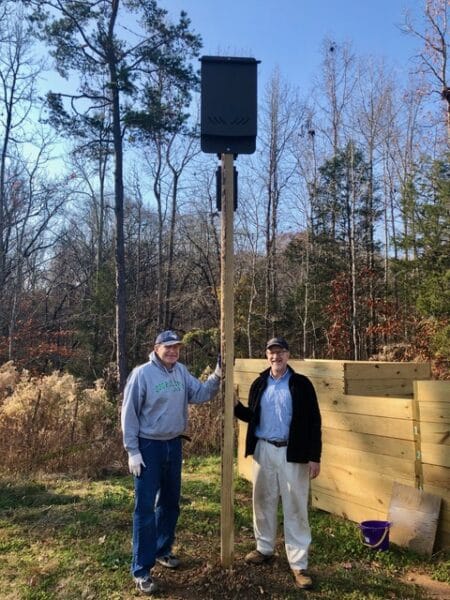NEWS
Going “Batty” at The Pines

Eric Johnson (l) and Dr. Mark Stanback
Soon after moving to The Pines from Vermont, we became aware of swarms of nasty little black mosquitoes that bit us when we were gardening or chatting with neighbors in our backyard. They were driving us “nutty!”
In Vermont, we lived on Lake Iroquois and later Lake Champlain and were never bothered by mosquitoes. At dusk, we welcomed our local little brown-nosed bat population that swooped down from the trees and out from behind shutters to spend the night eating their weight in mosquitoes. This can amount to eating 3,000 tiny insects in a single night. Come spring, we could hear squeaking behind our shutters as the bat brood grew.
Bats are fascinating. They are the only true flying mammal. There are over 1,400 species of bats in the world. A few basic bat facts will help you understand these amazing mammals. Bats communicate with each other through high frequency chirps, screeches, and songs. Bats hibernate in winter and use stored fat for fuel. By February, they are low on fuel and may leave their roost to find food or drink. In late March and April, they are active, hungry, and begin to move between roosts. By May, the females are forming maternity colonies. They give birth to a single pup, which they nurse on their milk. The pup is less than an inch long. At about three weeks, pups learn to fly. At six weeks, the young are catching their own insects. The females desert old nursery sites and seek males. Mating takes place in September and October. In November, they start to, once again, build up fat stores and begin to hibernate for the duration of the winter.
The Pines Nature Organization recently installed bat houses at The Pines by the soon-to-be garden plots that border the greenway. Dr. Mark Stanback, a biology professor at Davidson College, has been our go-to expert on bats. He explained that we already have bats on our campus, but these bats frequent attics and eaves rather than bat houses. There are colonies of Mexican free-tailed bats in Davidson, and it is these bats we are trying to attract to our four bat houses. Dr. Stanback helped us install a long pole that holds all four houses. One is a large box that will hold a large colony. The three smaller boxes will hold fewer but will still support the condo lifestyle these bats seek. The bat box was painted a dark color to retain heat as the Mexican free-tailed bats like a sunny location on a pole or the side of a building. Bat boxes should be 16 feet off the ground and not on a tree.
Our culture has always had concerns about bats. The bat we are attracting was named the state flying mammal in Texas. Mark said that rabies is not an issue. If these bats get sick, they crawl off and die. They don’t get aggressive, and, Ladies, fear not . . . they won’t get stuck in your hair! They are not out to bite us, and they don’t suck our blood.
If we do get a colony this year, it will arrive sometime in March, and the pups will be born in May. Next time you are walking, jogging, or biking the greenway by The Pines, pause and look through the trees towards The Pines parking lot.
At the far end of the lot is a grassy area where you will see the tall pole with our four bat boxes. Keep your fingers crossed. By summer, we may have fewer nasty mosquitoes.
Ginger Johnson
Ginger Johnson and her husband have recently moved from Vermont to The Pines. She earned her BS degree from Carroll University. She was a teacher until retirement, once owned a quilt shop, and currently calls herself a fiber artist. Ginger enjoys writing and has authored four books. She is the proud grandma to five grandchildren. She is happy to now call Davidson her home.


